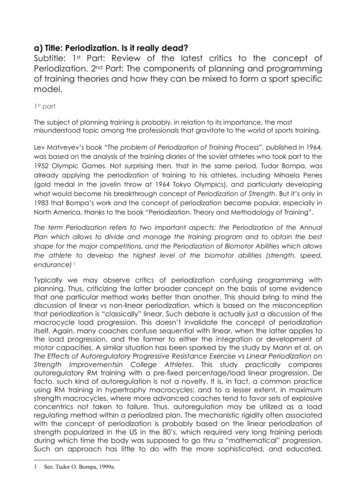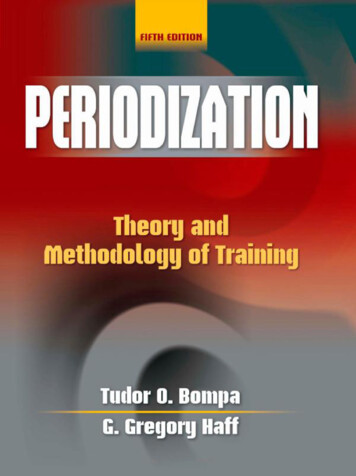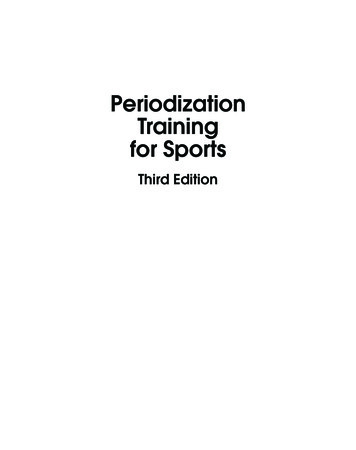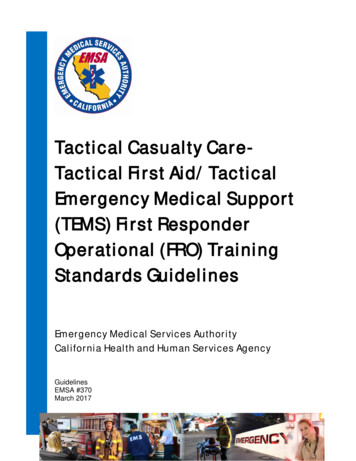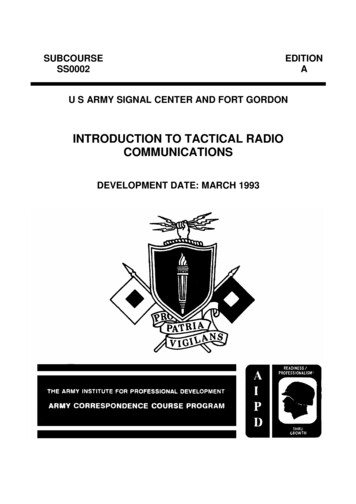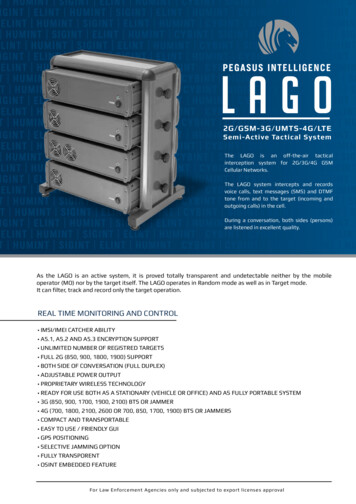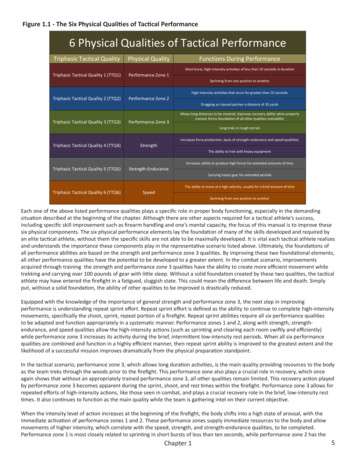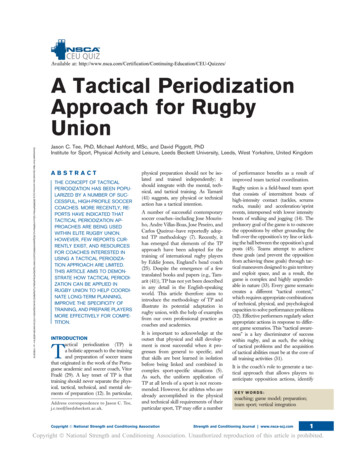
Transcription
A Tactical PeriodizationApproach for RugbyUnionDownloaded from https://journals.lww.com/nsca-scj by BhDMf5ePHKav1zEoum1tQfN4a yN64Q7Jhni4U34p/K45b n7G7x0 kt4/Okf elESFA on 11/06/2018Jason C. Tee, PhD, Michael Ashford, MSc, and David Piggott, PhDInstitute for Sport, Physical Activity and Leisure, Leeds Beckett University, Leeds, West Yorkshire, United KingdomABSTRACTTHE CONCEPT OF TACTICALPERIODIZATION HAS BEEN POPULARIZED BY A NUMBER OF SUCCESSFUL, HIGH-PROFILE SOCCERCOACHES. MORE RECENTLY, REPORTS HAVE INDICATED THATTACTICAL PERIODIZATION APPROACHES ARE BEING USEDWITHIN ELITE RUGBY UNION.HOWEVER, FEW REPORTS CURRENTLY EXIST, AND RESOURCESFOR COACHES INTERESTED INUSING A TACTICAL PERIODIZATION APPROACH ARE LIMITED.THIS ARTICLE AIMS TO DEMONSTRATE HOW TACTICAL PERIODIZATION CAN BE APPLIED INRUGBY UNION TO HELP COORDINATE LONG-TERM PLANNING,IMPROVE THE SPECIFICITY OFTRAINING, AND PREPARE PLAYERSMORE EFFECTIVELY FOR COMPETITION.INTRODUCTIONactical periodization (TP) isa holistic approach to the trainingand preparation of soccer teamsthat originated in the work of the Portuguese academic and soccer coach, VitorFradé (29). A key tenet of TP is thattraining should never separate the physical, tactical, technical, and mental elements of preparation (12). In particular,TAddress correspondence to Jason C. Tee,j.c.tee@leedsbeckett.ac.uk.physical preparation should not be isolated and trained independently; itshould integrate with the mental, technical, and tactical training. As Tamarit(41) suggests, any physical or technicalaction has a tactical intention.A number of successful contemporarysoccer coaches—including Jose Mourinho, Andre Villas-Boas, Jose Peseiro, andCarlos Queiroz—have reportedly adopted TP methodology (7). Recently, ithas emerged that elements of the TPapproach have been adopted for thetraining of international rugby playersby Eddie Jones, England’s head coach(25). Despite the emergence of a fewtranslated books and papers (e.g., Tamarit (41)), TP has not yet been describedin any detail in the English-speakingworld. This article therefore aims tointroduce the methodology of TP andillustrate its potential adaptation inrugby union, with the help of examplesfrom our own professional practice ascoaches and academics.It is important to acknowledge at theoutset that physical and skill development is most successful when it progresses from general to specific, andthat skills are best learned in isolationbefore being linked and combined incomplex sport-specific situations (5).As such, the uniform application ofTP at all levels of a sport is not recommended. However, for athletes who arealready accomplished in the physicaland technical skill requirements of theirparticular sport, TP may offer a numberof performance benefits as a result ofimproved team tactical coordination.Rugby union is a field-based team sportthat consists of intermittent bouts ofhigh-intensity contact (tackles, scrumsrucks, mauls) and acceleration/sprintevents, interspersed with lower intensitybouts of walking and jogging (14). Theprelusory goal of the game is to outscorethe oppositions by either grounding theball over the opposition’s try line or kicking the ball between the opposition’s goalposts (45). Teams attempt to achievethese goals (and prevent the oppositionfrom achieving these goals) through tactical maneuvers designed to gain territoryand exploit space, and as a result, thegame is complex and highly unpredictable in nature (33). Every game scenariocreates a different “tactical context,”which requires appropriate combinationsof technical, physical, and psychologicalcapacities to solve performance problems(32). Effective performers regularly selectappropriate actions in response to different game scenarios. This “tactical awareness” is a key discriminator of successwithin rugby, and as such, the solvingof tactical problems and the acquisitionof tactical abilities must be at the core ofall training activities (31).It is the coach’s role to generate a tactical approach that allows players toanticipate opposition actions, identifyKEY WORDS:coaching; game model; preparation;team sport; vertical integration1Copyright ª National Strength and Conditioning Association. Unauthorized reproduction of this article is prohibited.Copyright Ó National Strength and Conditioning AssociationStrength and Conditioning Journal www.nsca-scj.com
Tactical Periodization for Rugby Unionpredictable scenarios, and createa sense of order within this chaoticenvironment. This is achieved throughthe systematic planning and executionof training activities that emphasize thetactical principles the players shouldadopt within each moment of thegame. Consequently, this identifiesa need for coaches to have a clear ideaof the tactical approach their team willadopt. Lara-Bercial and Mallett (27)suggest that “simplifying complexity”and using simplified models to createa clear vision of success are key characteristics of “serial winning coaches.”In team invasion games, such as soccerand rugby union, the first step towarddeveloping such a vision involves thecreation of a “game model.”TACTICAL COACHING PRIORITIESTHE GAME MODEL ANDMOMENTS OF THE GAMEThe available writings on TP stress theimportance of a “game model”(2,7,12,29,41) that defines how the coachwants the game to be played. Importantly,the coach must create a game model—itcannot be adopted—and it must be simpleenough to represent the game in itsentirety but also be flexible enough forplayers to be creative (41). A clear gamemodel helps players to have a “sharedmental landscape” for the game and, thus,may enhance team decision-making (37).In soccer, proponents of TP often designgame models around the so-called “moments of the game,” which represent the4 main states a team may be in duringa match: (a) transition into attack, (b) attacking organization, (c) transition intodefense, and (d) defensive organization(12,41). However, given differences inrules (especially rules around contact),a slightly different “internal logic” existsin rugby union (19). In rugby union, physical contests for possession occur beforeall phases of play, and the outcomes ofthese contests influence the contextwithin which teams attack and defend.As such, the “contest for possession” becomes the central moment of the game,which influences all others (Figure 1).The game model is similar to the concept of a “shared mental model” asexplored by Richards et al. (36,37). Inconstructing a game model, coachesspecify the main tactical principles thatthe players should adhere to duringeach moment of the game (29). Thegame model allows coaches to communicate a “system” or “way of playing” to the playing group.Development of a game model followsa characteristic process. Initially, it isconstructed as the coach’s mental modelof how the game should be played, orwhat Richards et al. (36) call the “Alphaversion.” This “mental model” is developed through their understanding of thegame, incorporating knowledge of his orher own players’ abilities and limitations,an understanding of competition demands and of opponent’s strengthsand weaknesses. A mental model constructed in this manner provides a “performance vision” that allows the coachto communicate the ideal tacticalapproach in each moment of the gameto his or her players (36,37).The performance vision provides a clearidea of the technical, physical, and psychological demands that will be placedon the players in the execution of thegame model. This allows technical/tactical and strength and conditioning(S&C) coaches to clearly define the requirements of the chosen way of playingand determine the sport-specific skill setrequired, and hence the curriculum thatshould be followed (36). In a S&C context, this aligns with the welldocumented process of “needs analysis”(30) but increases specificity by considering the team’s intended style of play.After the creation and articulation ofthe performance vision, this vision isthen shared with the players, wherethe responsibility for its further development and operationalization becomes collaborative between theplayers and the coach. This empowersthe players to identify key cues anddevelopmental factors in the development of the tactical approach (36). Indoing so, the mental model transitionsfrom being the coach’s construct toa “shared mental model” betweencoaches and players, or what Richardset al. (36) call a “Beta version.” Theshared mental model provides a common framework and principles withinwhich players and coaches havea shared tactical understanding. It mustbe stressed that this approach is notintended to constrain behavior, norprescribe tactical solutions, but allowplayers the freedom to be creativeand make decisions within a frameworkof play (36). Fradé (cited in Martins(29)) suggests that tactical solutionsto a game should be “born in the player’s mind first,” stressing the importance of developing tactics betweencoaches and players collaboratively.PRINCIPLES OF PLAYUnder the framework of TP, eachmoment of the game has a characteristic structure that presents the teamwith a performance problem—how bestto achieve the team’s tactical goal forthat moment of the game within theconstraints presented by the opposition. Because of the complex natureof sport, no two moments of play willFigure 1. Moments of the game for rugby union.VOLUME 40 NUMBER 5 OCTOBER 20182Copyright ª National Strength and Conditioning Association. Unauthorized reproduction of this article is prohibited.
ever be exactly identical, and it isimpossible to practice for every scenario players will experience on thefield. To reduce this complexity, teamsmay apply a set of principles and subprinciples to guide the tactical responses (29). These principles andsub-principles provide a sort of heuristic to guide team responses in the chaotic environment. Consequently, thisrequires a hierarchy of principles andsub-principles to guide behavior withineach moment of the game (Figure 2).PLANNINGImplementing TP requires exceptionalplanning to “operationalize” team tacticsthrough the systematic repetition andprogression of training goals. Nestedplanning (1) refers to shaping learningtoward a set of macro-associated (longterm) goals and aligning different areasof learning and development to specified time frames. The different momentsof the game and the principles thatunderpin them mean that a range oflearning activities have to be completedto meet the set objectives. The coachingplan needs to ensure that sufficientlearning opportunities are providedaround the principles of play for thevarious moments of the game. In addition, planning must ensure the necessarydevelopment of required technical skills,physical abilities and mental attributes.As such, planning needs to progressalong 2 temporal levels: (a) short-termprogression from game to game thatneeds to be aligned with (b) mediumand long-term progression over thecourse of the season or multiple seasons.This nested-planning approach allowsfor performance stabilization in theshort term, ensuring that a team is optimally ready to perform during regularweekly competition but also ICAL CONDITIONING WITHINTACTICAL TRAININGAlthough the evidence for TP improving team-sport performance outcomesis anecdotal at present, similar approaches (36,42,43) have been shownto be beneficial. The intermittent, contact nature of rugby union requires players to have well-developed endurance,high-intensity, speed, strength andpower capabilities (17). These physicalqualities may be best developed throughfocused, isolated training blocks (22),but in reality competition structuresnecessitate that these qualities are developed concurrently. In particular, highlevels of muscular strength and hypertrophy are essential for elite performance in rugby union (17). S&Ccoaches will be concerned aboutwhether it is possible to illicit therequired physical adaptations for performance by foregoing traditional conditioning methods in favor of a TPapproach.It is clear that the necessary strengthand hypertrophy required for elite performance cannot be developed solelythrough on-field conditioning practices. Resistance training methods areindispensible in rugby union (17), andit follows that training can thereforenever be wholly tactical in nature.There is, however, scope within theprescription of resistance training toalign training stimulus with on-fieldactivities to improve transfer of physical abilities from the weight room tothe field (4). For example, a field session with a focus on acceleration,Figure 2. Game model for rugby union demonstrating principles of play for each moment of the game.3Copyright ª National Strength and Conditioning Association. Unauthorized reproduction of this article is prohibited.Strength and Conditioning Journal www.nsca-scj.com
Tactical Periodization for Rugby Uniondeceleration, and collisions could besuccessfully paired with a gym sessionincorporating heavy sled towing. Further examples of how resistance training could be used to complementtactical training sessions are providedin Table 2.In contrast to resistance training, tactical training sessions represent an idealopportunity to develop game-specificspeed, physical endurance, andrepeated high-intensity effort abilitiesin situ. The effectiveness of thisapproach has been previously demonstrated (16,18,44). For example, maximal velocity is noted as an importantphysical quality for rugby union performance (14), but maximal velocity isa difficult quality to improve withina team sport environment (3,23). In thiscontext, training dedicated specificallyto improving linear maximal velocityfor rugby may be taking time awayfrom tactical development activities.Instead “relative” or “game-specific”speed may be a much more importantparameter for performance and can betrained within a game context (16).Abilities such as changing direction athigh speed to avoid a defender andaccelerating through contact or maintaining speed while catching a pass aremuch more likely to have an effect onmatch performance. These skills arebetter trained using skill and gamebased approaches rather than linearspeed drills (10).In this light, the transfer of physicalabilities to game performance will bebetter for abilities developed throughan integrated model of training. It hasalready been demonstrated thata conditioning games approach iseffective for developing endurance fitness in professional rugby players(18). In addition, recent research hasdemonstrated that manipulating theconstraints in various small-sidedgames allows coaches to adapt thephysiological stresses placed on participants (44). Based on this information, the integrated approach totraining advocated by TP may beeffective for conditioning rugby unionplayers.Figure 3. Typical structure of a tactical periodization training plan for soccer for (A) a 6-day turnaround and (B) a 5-day turnaround.VOLUME 40 NUMBER 5 OCTOBER 20184Copyright ª National Strength and Conditioning Association. Unauthorized reproduction of this article is prohibited.
VERTICAL INTEGRATIONA key principle of the TP model is theconcept of “horizontal alternation ofspecificity” (12,41) (direct translation)but is operationally similar to CharlieFrancis’ “vertical integration” approachto physical training (15). This describesthe manipulation of training activitiesto emphasize the development of different physical and tactical abilitiesthroughout the training week. Thus,no two days within a given week stressthe same physical fitness or tacticalcomponent. Training emphasis isswitched on a daily basis to ensure balanced physical development and toallow adequate recovery of the physical fitness component stressed duringthe previous session. TP models forsoccer typically aim to include trainingdays that emphasize strength, endurance, speed, and recovery during thetraining week. The hypothetical structure of typical training weeks under thisapproach is illustrated in Figure 3.The differing physical components areemphasized by varying the playingtime, playing area, playing numbers,and technical and tactical complexityof training activities throughout theweek (Table 1). In accordance withthe principle of overload, trainingshould aim to exceed the typical matchdemands of whichever physical qualityis being trained on that day. Examplesof integrated TP training sessions forsoccer have been provided by Buchheitet al. (4). It is important to note thatthese terms (i.e., “strength,” “endurance”) in the context of TP literaturehave different meanings to those traditionally used in the strength and conditioning literature. For example,“strength” training refers to a sessionwhere the emphasis is on playinggames in small spaces to overloadacceleration and deceleration demands. Going forward, in this text,we will attempt to apply some moreuniversally accepted descriptors.Applying the concept of vertical integration to rugby training requiresconsideration of a number of rugbyspecific factors. Of primary concern isthe frequency of physical contactwithin rugby union. Professional rugbyplayers are involved in multiple contact events during match play (10–25tackles, 7–74 rucks/mauls) (13), whichsignificantly increases the overall physical exertion experienced by players(24). Contact training needs to beundertaken regularly during rugbytraining to improve tackle and ruckefficacy (21), but contact skills trainingcomes at a cost of physical trauma andfatigue (40). For this reason, the positioning of contact training sessionswithin the training week requires special consideration. It takes at least 48hours to recover from rugby matchplay (38) and at least 24 hours torecover from contact training sessions(39). Therefore, we suggest that contact skills training is placed in the middle of the training week to allow forTable 1Soccer-specific tactical periodization emphasizing different physical stresses in trainingTraining emphasisStrength sessionEndurance sessionSpeed sessionRecovery sessionTraining goalHigh density ofacceleration/deceleration, change ofdirection, jumping andshooting activitiesExceed average match Very high velocity ofmovement and andemands in totalexaggerated speedvolume and relativeof decision makingdistance (m/min)Physical demands that aresimilar to match play, butfor shorter duration withmuch longer rest periodsGroup sizeMedium to small, evennumbers of attackersand defenders, e.g., 5versus 5 or 4 versus 3Large, e.g., 10 versus10 or 10 versus 8Medium to small, attackersoutnumber defenders, e.g.,8 versus 2 or 4 versus 2Playing areaSmall, e.g., 20 3 30 mMedium to large, e.g., Medium, e.g., 40 330 m50 3 60 m or fullfieldMedium to small, e.g., 30 330 m or 15 3 20 mInterval timeShort with frequent restperiods, 3–5 minLong intervals,20–30 minVery short withfrequent restperiods, 1–2 min10–15 minRecovery between Partial recovery, 3–5 minintervalsComplete recovery,5–8 minPartial recovery,2–4 minComplete recovery, 5–8 minIntervals per set2–312–31No. of sets4–61–34–63–4Medium, attackersoutnumberdefenders, e.g., 8versus 45Copyright ª National Strength and Conditioning Association. Unauthorized reproduction of this article is prohibited.Strength and Conditioning Journal www.nsca-scj.com
both maximum recovery from the previous match and to allow full recoverybefore the next match (Figure 4). Theplacement of the contact training session “anchors” the rest of the trainingweek. Rugby players generally have atleast 2 rest days in a 7-day microcycle,meaning that they effectively have 1less training day per week than soccerplayers. This is similar to the 6-daymicrocycle in soccer (Figure 3B). Suggested training parameters for all vertical integration sessions are provided inTable 2, with explanations in thetext below.1RM 5 1 repetition maximum; TP 5 tactical periodization.Speed-strength/power: Olympic No resistance trainingStrength-speed/acceleration: sled push/pullFull body strength: squat, hipComplimentarylift variations, plyometrics;variations, Olympic lift variations; sets/reps: 5hinge, push, pull with unilateral/resistancesets/reps: 5 3 3–5; intensity:3 1–3; intensity: .85% 1RM—accelerationbilateral options; sets/reps: 3 3training session0–70% 1RM—velocityemphasis5–8; intensity: 65–85% 1RMemphasis3–44–61–3No. of sets4–63–46–83–51No. of intervals60–120 sRecovery between Complete, 5–8 minintervals60 s60 s2–330–60 s60–120 s20–30 minInterval timeMedium to large, e.g., 503 60 m or full fieldMedium, e.g., 60 3 50 mMedium to large, e.g., 50 3 60 m or Small, e.g., 15 3 20 mfull fieldPlaying areaLarge, e.g., 15 versus 8Medium, e.g., 10 versus 7Medium to small, e.g., 5 versus 5Large, e.g., 10 versus 10 or 10versus 8Group sizeSimilar to or belowmatch intensity forshort periods of play,with long periods ofrecoveryElevated speed of decisionHigh density of contact involvements (tacklesDevelop endurance capacity;making, movement actions,and/or rucks), acceleration, deceleration, andrunning intensities and volumesand tactical execution; somechanges of directiongreater than match play; nocontact involvementphysical contactTraining goalActive Recovery sessionSpeed sessionTraining emphasis Noncontact work capacity session Contact, acceleration and deceleration sessionsTable 2Rugby-specific TP model emphasizing horizontal alternation of different physical stresses throughout the training weekTactical Periodization for Rugby UnionIn the rugby context, it may be favorable to place a non-contact workcapacity session on Monday (aftera Saturday match) for 2 reasons. First,players do not fully recover during thefirst 48 hours after match involvement(39) and so should not be exposed tofurther collisions or high-intensity exertions during this period. Second, therunning demands of rugby unionmatch play are relatively low (6), andin the absence of contact these can beachieved and exceeded relatively easilyduring conditioning games (24). Thisindicates that the aerobic abilityrequired for performance can be maintained through these non-contact workcapacity sessions while simultaneouslydeveloping skills and/or tacticalawareness. These sessions could beseen as similar to the “endurance” or“recovery” sessions advocated in theTP literature.In addition to the positioning of contact training during the week, the“dose” of contact players are exposedto in training is an important consideration. Analysis of ball-in-play time inrugby union has shown that, on average, the ball is in play for 26 seconds,with the longest ball in play phase reported as 113 seconds, and the averageball out-of-play time is 59 seconds (34).The mean contact demands of rugbyshow that players may be exposed to0.56 contact events per minute (28),but this figure may increase to 0.89collisions per minute during the longest periods of play (35). Based on thisanalysis, relative overload can beVOLUME 40 NUMBER 5 OCTOBER 20186Copyright ª National Strength and Conditioning Association. Unauthorized reproduction of this article is prohibited.
achieved within a contact skills sessionby ensuring that work intervals last for1–2 minutes so that players areinvolved in approximately 1 collisionper minute. Contact training sessionsrely largely on players both generatingmomentum through rapid accelerationand negating other player’s momentum during contact phases. The abilityto close space quickly and realigneffectively are determinants of successfor defenders. As such, accelerationand deceleration abilities are naturallystressed through contact-focused technical/tactical activities, and these canbe further emphasized through the useof small playing areas and evenlymatched team sizes (44).Speed emphasis training in rugbyunion should look to accentuate bothspeed of decision making and speed ofmovement. It is during this session thatplayers should accumulate most oftheir maximum velocity (VMax) running volume for the week. Analysis ofthe “worst-case” scenario during international match play has shown that themaximum distance covered in a 1-minute interval is 184 6 28 m (11). Thisindicates that a mean intensity of 200m/min during work intervals will satisfy the overload requirement for speedduring these sessions. It is importantthat players achieve both individualVMax and worst-case scenario meanrunning intensities at times during thissession, although these need not beconcurrent.Because these training sessions takeplace in the presence of a main emphasis on technical/tactical skill development, there will be a great deal ofvariation between work intervals. Microtechnology is hugely valuable tothe S&C coach in assessing whetherthe session goals have been achievedand in providing feed-forward information to further improve subsequenttraining sessions (9).Using a TP structure emphasizes consistency of training prescription acrossmultiple competition weeks. This ensures that players receive adequate(hopefully optimal) stimulation eachweek for each of the important physiological parameters for performance.In the long-term, this is likely to produce consistency in physical performance, avoiding undesirable peaksand troughs during the season.SESSION TO SESSIONIMPLEMENTATIONThe principle of “conditioned practices”can be used for the planning of individual training sessions within the largertraining plan (12). Effective conditionedpractices rely on the coach shapingtraining around the targeted principlesof play and associated key behaviors. Itis suggested that this should be split into2 dimensions: (a) the tactical/technicaldimension (motor behaviors, cognitivefunctioning) and (b) the physiologicaldimension (physical load) (12). Appreciating these 2 factors will allow coachesto manipulate the levels of intensity toensure the tactical “vision” of the principle is met. In Kerr’s (26) study of the“All Blacks” rugby team, for example,coaches and players confessed that tactical elements, such as decision-making,physical intensity, and the number ofrandomized situations incorporatedwithin training, far exceeded the demands of an elite international rugbymatch. This highlighted the overall goalof their training: for training to be harder than the game.The holistic nature of TP means thata number of demands can beincreased to affect session demands.Coaches can manipulate the levels ofcognitive load, technical skills, tacticalunderstanding, physical stress, anxiety, and complexity of movementsdepending on the desired goal. Tanet al. (42) theorized 4 pedagogicalprinciples that can allow for learningto occur: (a) tactical complexity, (b)representation, (c) exaggeration, and(d) tactical transfer. Coaches canapply these principles to challengetheir players to understand themoment of the game (as informedFigure 4. Proposed structure of a tactical periodization training week for rugby.7Copyright ª National Strength and Conditioning Association. Unauthorized reproduction of this article is prohibited.Strength and Conditioning Journal www.nsca-scj.com
VOLUME 40 NUMBER 5 OCTOBER 2018Date: October 6, 2017Phase: early in-seasonTotal time: 1 hTactical Session aims:Game moments: defense organization (DO) and transition from defense to attack (TDA)Tactical scenario: goal line defense (DO)Sub-principle: high line speed (get away from the line)Sub-sub-principles: compress/safety in numbers; win the body height battleTactical scenario: goal line turnover (TDO)Sub-principle: identify space and transfer ball there quicklySub-sub-principles: eyes up; effective communicationTechnical: appropriate bodyposition/height for goal linedefenseActivityPhysical: “strength” emphasis—frequent collisions andaccelerationsStructureMental: siege mentality—holdthe line at all costsKey coaching pointsWarm-up/introduction1) Wrestling (contact readiness)1 versus 1, both players onknees, 5 3 20-s bouts with40-s recovery.Players aim to pin opponents’shoulders. Relates to bodyheight battle (technical)—cannot let opponent getunderneath you!2) 2 versus 1 tacklingFrom standing start, ball carrieraims to carry ball between 2defenders. Defenders aim tohold player up/drive himback. Five carries per player ina group of 3.Primary defender target hips/thighs (low). Secondarydefender wrap upper body,lend weight (technical).Copyright ª National Strength and Conditioning Association. Unauthorized reproduction of this article is prohibited.Tactical Periodization for Rugby Union8Table 3Sample session plan focused on defensive organization, illustrating the incorporation of tactical periodization principles into session planning
Table 3(continued )Game/activity 1: small spacegoal line defense5 versus 5 in 15 3 15 m.Multiple grids to ensure allplayers involved. 6 3 60 sbouts with 60 s rest betweeneach (each team defend 33).If teams score within 60 sthrow in a new ball andcontinue.Tactical: 1) Attackers mustcommit players to keeppossession; defenders havenumbers advantage if notinvolved in ruck. Make gooddecisions regarding when tocompete. 2) Attackers canattack either side of ruck,therefore eyes up and matchnumbers. 3) Relieve pressurethrough consistent hard linespeed.Technical: 1) Maintain bodyheight/tackle technique. Aimfor 2 versus 1 tackles.Strength and Conditioning Journal www.nsca-scj.comMental: 1) Additionalconsequences for conceding.2) Agitated/angry coachingbehaviors to increasepressure. 3) Deliberatelyunfair refereeing during somebouts to develop resilience.Game/activity 2: increase focusclose to goal line8 versus 8 in 30 3 22 m.Constraint 5 field widthnarrows nearer goal line(see figure).6 3 120-s bouts with 60-s restbetween each (each teamdefend 33). If teams scorewithin 120 s, restartimmediately from top of grid.Tactical: 1) Further dangerrelated to width (attackersgoing round you), closer togoal line danger related toattackers going through you.Awareness of need tocompress defense andincrease line speed closer toline.Technical: 1) Remain connec
ent game scenarios. This “tactical aware-ness” is a key discriminator of success within rugby, and as such, the solving of tactical problems and the acquisition of tactical abilities must be at the core of all training activities (31). It is the coach’s role to generate a
